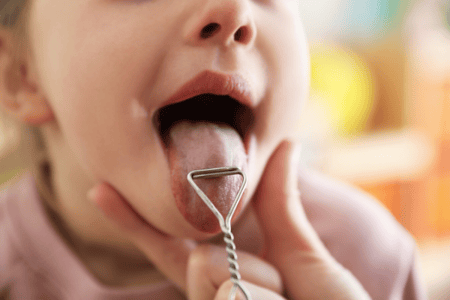
The health of your mouth can tell a lot about the health of your body overall. The tongue in particular is the part of the body we use for many important activities like talking, eating, and even kissing!
The tongue plays an important role in:

The systems of the human body are complex and interconnected. Even small membranes like those found in your mouth can play a big role in your body’s overall health. The tiny piece of tissue under your tongue is actually connected to your fascia — the thin layer of connective tissue that supports and surrounds every bone, muscle, organ, blood vessel, and nerve fiber in your body. This would indicate that this very short and tight oral restriction or tether can directly and indirectly affect the rest of your body.
We all have frenula (plural for frenum) in our mouths. A frenum is the word for a piece of soft tissue that helps to anchor a semi-mobile body part, such as your lips, cheeks and tongue. A frenulum is just a name for a small frenum.
If you look in the mirror while lifting your tongue, you will see a band of tissue connecting your tongue to the bottom of your mouth. This is called the lingual frenulum. If you lift up your top lip, pull down your bottom lip, or peek inside your cheeks you will also find smaller oral tethers between the lips and gums. These are called labial frenums.
These small tethers in your mouth serve a purpose — they provide stability for your tongue, lips and cheeks. If the strand of tissue anchoring your tongue to your mouth is too tight, too stiff or too short, it can interfere with the normal muscle movement and function. This is especially true when it comes to the tongue muscle. This can lead to health problems at each stage of your development, whether or not you have symptoms early on.
Here’s a simple exercise you can do to help understand the important role the tongue plays in daily functions we often take for granted. Try to swallow while keeping your tongue firmly at the bottom of your mouth. Not so easy right? Or grab the end of your tongue and say the word “apple” really loud three times. The restriction of your tongue will change this good tasting five word into, well, a bad word you may not want to say out loud in a crowded room.
Although this was a temporary restriction, just imagine if it was permanent. This can give you a glimpse of the struggles and discomfort experienced by people with an oral restriction every single day.
Tongue tie, lip tie, and buccal tie are conditions present at birth that restrict the normal movement and function of the tongue and mouth.
.png?width=850&name=Tongue-lip-buccal-tie%20(1).png)
During the normal development of a fetus in the womb, tissue forms to anchor the tongue to the base of the mouth. In most cases, this tissue naturally dissolves to a small, flexible tether around the 12th week of pregnancy.
In some fetuses, this tissue does not dissolve, leaving a “left-over” tie that is especially short, tight or thick, which can restrict normal tongue movement. A lot of premature babies have an oral restriction because they were born before the tissue separated adequately in utero.
Although more research is needed to better understand the causes of this condition, some evidence points to a genetic mutation known as MTHFR (methylenetetrahydrofolate reductase). Tongue tie is hereditary and is often passed down from one generation to the next. It is often present in babies who are born with birthmarks known as “stork bites.”
Tongue , lip and buccal ties come in various shapes, sizes, and levels of restriction — but what is key is the symptoms that they cause for the individual and to their family as a whole.

The symptoms of tongue tie are varied and can differ depending on the person and their age.
You may notice that your baby is:
If you are nursing your baby, you may notice:
You might notice that your toddler is having:
In children you may notice:
If you are a teen or adult you may notice:
While one tongue tied baby might have all of the classic symptoms, another baby with a similar tether might not present any symptoms at all. Why is this? The baby showing no symptoms might be compensating for their restriction.
This compensation can lead to a “domino effect” of related problems throughout their life. Some tongue tie specialists suspect that there are millions of adults with undiagnosed oral restrictions that contribute to health problems that they encounter much later in life such as sleep apnea and migraines.
In babies, an oral restriction can lead to complications with breastfeeding. The lack of tongue mobility can impair their ability to properly latch, suck, and swallow. This is why many oral restrictions are discovered and diagnosed due to difficulties with breastfeeding. It's a great idea to check for oral restrictions in a baby if its breastfeeding mother has mastitis symptoms, decreasing milk supply, or clogged ducts.
The ideal time to diagnose and treat a tongue tied baby is shortly after birth. The longer we wait the more problems that arise. Plus, if some of the oral muscles are restricted and we compensate by using other muscles not intended for suck and swallow, the brain quickly memorizes these dysfunctional patterns.

If an oral restriction is not diagnosed or treated at an early stage, it can influence a range of health problems over the course of a lifetime. If ignored or never diagnosed, it can lead to a cascade of developmental issues in the mouth and even in the rest of the body.
The muscles, if restricted, can cause a FUNCTIONAL problem, which is often called an oral dysfunctional pattern. Muscles influence bone. Bone will change shape based on the pressure or tension placed upon it. Thus, a functional problem can lead to a STRUCTURAL problem. Finally, we are starting to learn how structural problems can lead to BEHAVIORAL problems.

FUNCTIONAL effects of not treating an oral restriction:
STRUCTURAL effects of not treating an oral restriction:
BEHAVIORAL effects have been linked to:
Many clinical specialists in this field suspect that oral restrictions are related to serious, chronic conditions such as sleep apnea, asthma, heart issues, mental health problems, and acid reflux causes. More research is needed in this area to find out if restrictive oral tethers could be related to what causes migraine headaches and other relatively common health problems.
Many parents are concerned about ADHD symptoms in kids, and wonder about the cause of ADD in children. Few would consider that an oral restriction could be a part of the problem. Yet some medical professionals are looking into possible links between oral restrictions and attention deficit disorders due to the way the condition affects breathing and sleep.
This is because tongue tie is indirectly related to breathing, cardiovascular dysfunction, and sleep function. For instance, if you have tongue tie, you are impacting the vagus nerve, which goes right to the brainstem.
The vagus nerve is a long and complex nerve that connects to the brain, running through the face and chest to the abdomen. It communicates through vital parts of the body with the brain, impacting the heart, the digestive system, and the lungs.
There are two branches of the autonomic (involuntary) nervous system. The first is our hyperarousal mode. You may have heard of the “fight or flight” response. This is when the sympathetic nervous system is activated, usually by something in your environment that your body perceives as potentially dangerous.
For example, imagine that you are walking down the street and are suddenly startled by a large, snarling dog. You will feel an instant change in your body. Your heart rate will go up, your will muscles tense, and your breathing will speed up to oxygenate your body and prepare to either fight or run away.
In contrast to the acute stress response, the second branch is a homeostatic mode called the parasympathetic nervous system. This is known as “rest and digest” mode and restores the body to a calm relaxed state.
What do these systems have to do with oral restrictions? Healthcare professionals who deal with many patients with oral restrictions notice that they show signs of being in a sympathetic (fight or flight) state. They notice that babies with oral restrictions tend to have clenched fists and may have difficulty sleeping. Although much more research needs to be done in this area, the impact of oral restrictions on the vagus nerve and sympathetic nervous system could have implications for long-term mental health.
If you suspect your child could be tongue tied, it is important to make sure to get an examination and assessment by a healthcare professional who is familiar with the signs, symptoms and diverse appearance of oral restrictions.
Although the definition and diagnosis of oral restrictions has been around for centuries, there continues to be a lack of foundational training principals in many medical and dental schools in regards to assessment of oral restrictions. Thus, it is important to know where to go and who is assessing this condition.
Furthermore, some types of these tethers can be “hidden.” These may restrict movement and function despite looking like a “normal” tether. An anterior tongue tie is easier to see because it is closer to the tip of the tongue and the gumline. A posterior tongue tie can be harder to see because it is located further underneath the tongue, deeper in the mouth.

It is very common for parents to be told their baby is not tongue tied because their practitioner lacked specific training and experience in diagnosing oral restrictions. A common misconception is that a baby or child can “grow out of” it or that their tether can stretch as they get older. In many cases, a tongue issue will persist throughout life and can impact health.
A knowledgeable provider can analyze not only the physical appearance of the oral tether and symptoms but is also able to recognize if the patient is compensating for a restriction. More and more dentists are educating themselves when it comes to oral restrictions as the mouth and the surrounding tissues are their main scope of practice.
The little piece of tissue restricting the oral mechanics has opened the door to a blossoming relationship between healthcare professionals from a variety of specialties. The more healthcare professionals communicate with each other about this issue, the more they are seeing the same symptom lists in their patients. It is an exciting time for all health professionals as many are making these connections between these oral restrictions and other “whole body” implications.
Oral restrictions can be treated with a quick outpatient procedure to release the tie, sometimes referred to as a tongue tie surgery. A frenectomy is usually done with a laser and may completely eliminate (“ablate”) the tissue restricting the tongue or lip. This differs from a frenotomy, which is usually done with sterile scissors and involves “clipping” or “snipping” the tissue.
The type of healthcare professional who can perform the release is most often a dentist, doctor, naturopath, nurse practitioner, oral surgeon, or other provider.
You may have heard that an oral tie release procedure is a “magic” solution that will instantly remedy symptoms and related health problems. Unfortunately, this is just not so. It is very important to have a team of specialists to support a long-term approach that addresses the many health issues that an oral restriction can influence.
For example, an occupational therapist or speech and language pathologist can help with issues such as communication or sucking and swallowing skills. Meanwhile, an oral surgeon or orthodontist can help to correct some of the damage done to the body structures of the face and teeth.
There is no “one-size-fits-all” formula. A personalized, whole-health approach with a team of specialists from various disciplines can yield a better outcome overall.

Treating an oral restriction like tongue tie requires more than just a simple "snip or clip." Oral restrictions can cause short- and long-term health issues that are different for each age, which requires a custom treatment plan built just for you.
To set yourself up for success, you want a team that communicates with each other across disciplines for a holistic health approach. A custom, multi-disciplinary approach to address accompanying issues like oral dysfunction, speech & language issues, and airway health & sleep will help your family have the best possible outcome.